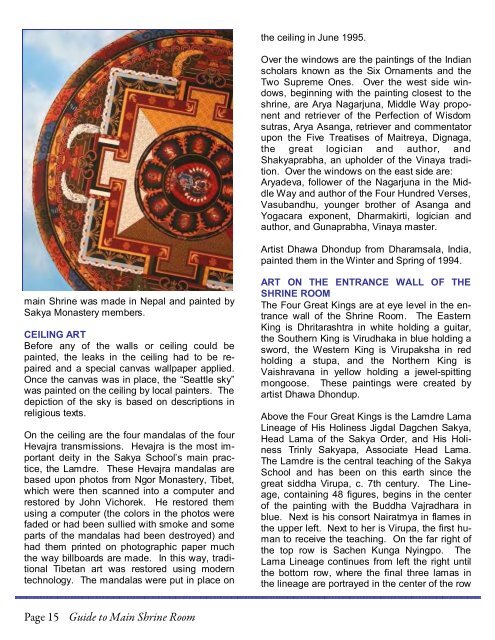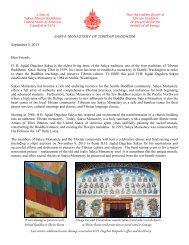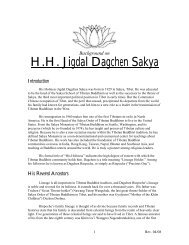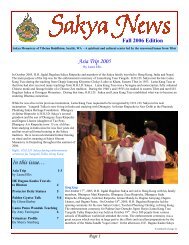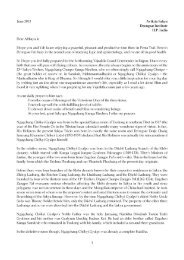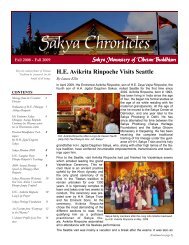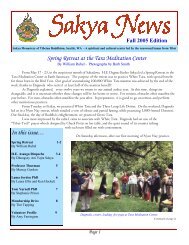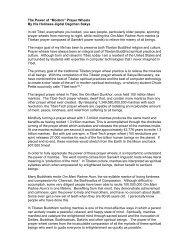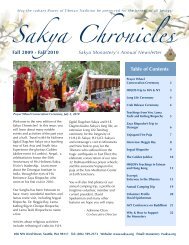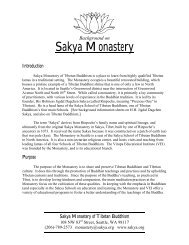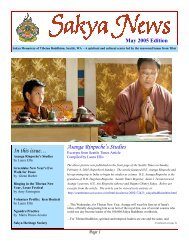Sakya Monastery of Tibetan Buddhism - the Sakya Monastery of ...
Sakya Monastery of Tibetan Buddhism - the Sakya Monastery of ...
Sakya Monastery of Tibetan Buddhism - the Sakya Monastery of ...
You also want an ePaper? Increase the reach of your titles
YUMPU automatically turns print PDFs into web optimized ePapers that Google loves.
<strong>the</strong> ceiling in June 1995.Over <strong>the</strong> windows are <strong>the</strong> paintings <strong>of</strong> <strong>the</strong> Indianscholars known as <strong>the</strong> Six Ornaments and <strong>the</strong>Two Supreme Ones. Over <strong>the</strong> west side windows,beginning with <strong>the</strong> painting closest to <strong>the</strong>shrine, are Arya Nagarjuna, Middle Way proponentand retriever <strong>of</strong> <strong>the</strong> Perfection <strong>of</strong> Wisdomsutras, Arya Asanga, retriever and commentatorupon <strong>the</strong> Five Treatises <strong>of</strong> Maitreya, Dignaga,<strong>the</strong> great logician and author, andShakyaprabha, an upholder <strong>of</strong> <strong>the</strong> Vinaya tradition.Over <strong>the</strong> windows on <strong>the</strong> east side are:Aryadeva, follower <strong>of</strong> <strong>the</strong> Nagarjuna in <strong>the</strong> MiddleWay and author <strong>of</strong> <strong>the</strong> Four Hundred Verses,Vasubandhu, younger bro<strong>the</strong>r <strong>of</strong> Asanga andYogacara exponent, Dharmakirti, logician andauthor, and Gunaprabha, Vinaya master.Artist Dhawa Dhondup from Dharamsala, India,painted <strong>the</strong>m in <strong>the</strong> Winter and Spring <strong>of</strong> 1994.main Shrine was made in Nepal and painted by<strong>Sakya</strong> <strong>Monastery</strong> members.CEILING ARTBefore any <strong>of</strong> <strong>the</strong> walls or ceiling could bepainted, <strong>the</strong> leaks in <strong>the</strong> ceiling had to be repairedand a special canvas wallpaper applied.Once <strong>the</strong> canvas was in place, <strong>the</strong> “Seattle sky”was painted on <strong>the</strong> ceiling by local painters. Thedepiction <strong>of</strong> <strong>the</strong> sky is based on descriptions inreligious texts.On <strong>the</strong> ceiling are <strong>the</strong> four mandalas <strong>of</strong> <strong>the</strong> fourHevajra transmissions. Hevajra is <strong>the</strong> most importantdeity in <strong>the</strong> <strong>Sakya</strong> School’s main practice,<strong>the</strong> Lamdre. These Hevajra mandalas arebased upon photos from Ngor <strong>Monastery</strong>, Tibet,which were <strong>the</strong>n scanned into a computer andrestored by John Vichorek. He restored <strong>the</strong>musing a computer (<strong>the</strong> colors in <strong>the</strong> photos werefaded or had been sullied with smoke and someparts <strong>of</strong> <strong>the</strong> mandalas had been destroyed) andhad <strong>the</strong>m printed on photographic paper much<strong>the</strong> way billboards are made. In this way, traditional<strong>Tibetan</strong> art was restored using moderntechnology. The mandalas were put in place onART ON THE ENTRANCE WALL OF THESHRINE ROOMThe Four Great Kings are at eye level in <strong>the</strong> entrancewall <strong>of</strong> <strong>the</strong> Shrine Room. The EasternKing is Dhritarashtra in white holding a guitar,<strong>the</strong> Sou<strong>the</strong>rn King is Virudhaka in blue holding asword, <strong>the</strong> Western King is Virupaksha in redholding a stupa, and <strong>the</strong> Nor<strong>the</strong>rn King isVaishravana in yellow holding a jewel-spittingmongoose. These paintings were created byartist Dhawa Dhondup.Above <strong>the</strong> Four Great Kings is <strong>the</strong> Lamdre LamaLineage <strong>of</strong> His Holiness Jigdal Dagchen <strong>Sakya</strong>,Head Lama <strong>of</strong> <strong>the</strong> <strong>Sakya</strong> Order, and His HolinessTrinly <strong>Sakya</strong>pa, Associate Head Lama.The Lamdre is <strong>the</strong> central teaching <strong>of</strong> <strong>the</strong> <strong>Sakya</strong>School and has been on this earth since <strong>the</strong>great siddha Virupa, c. 7th century. The Lineage,containing 48 figures, begins in <strong>the</strong> center<strong>of</strong> <strong>the</strong> painting with <strong>the</strong> Buddha Vajradhara inblue. Next is his consort Nairatmya in flames in<strong>the</strong> upper left. Next to her is Virupa, <strong>the</strong> first humanto receive <strong>the</strong> teaching. On <strong>the</strong> far right <strong>of</strong><strong>the</strong> top row is Sachen Kunga Nyingpo. TheLama Lineage continues from left <strong>the</strong> right until<strong>the</strong> bottom row, where <strong>the</strong> final three lamas in<strong>the</strong> lineage are portrayed in <strong>the</strong> center <strong>of</strong> <strong>the</strong> rowPage 15 Guide to Main Shrine Room7


